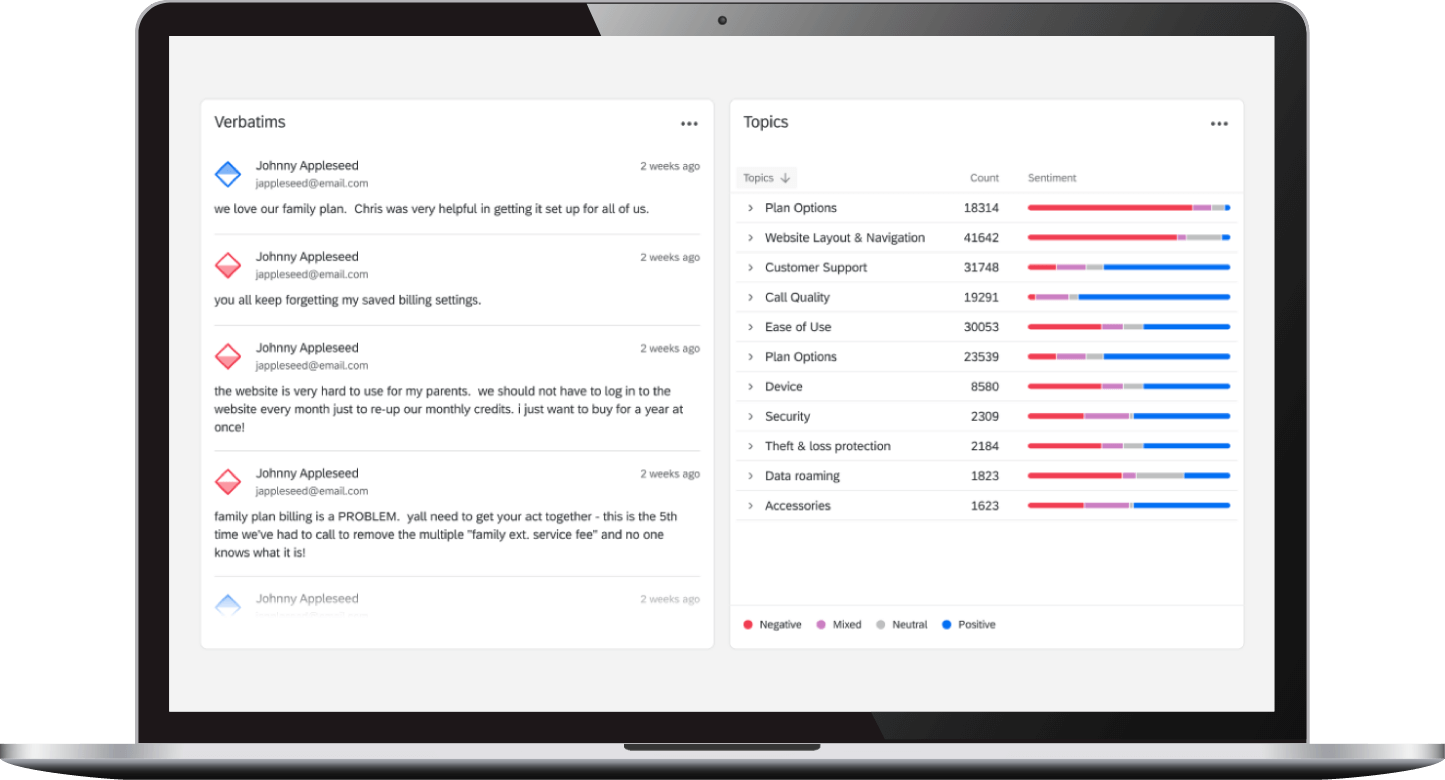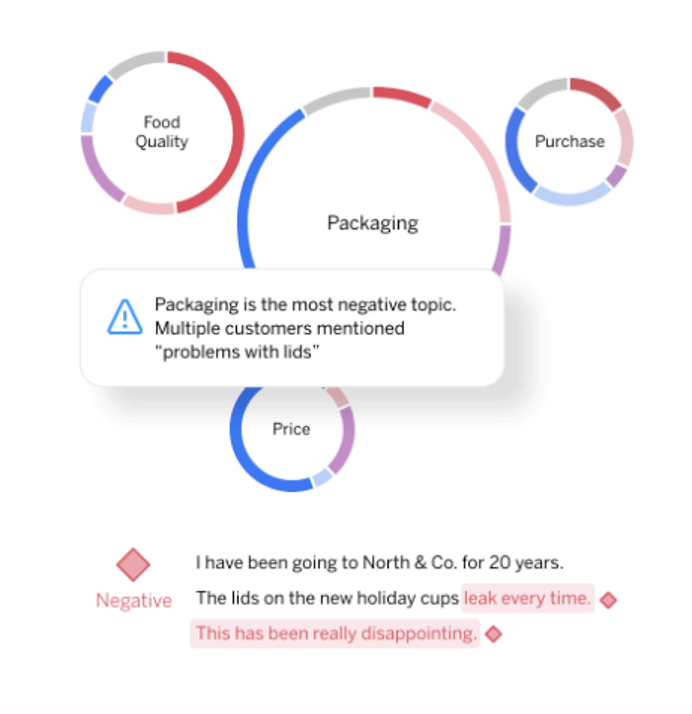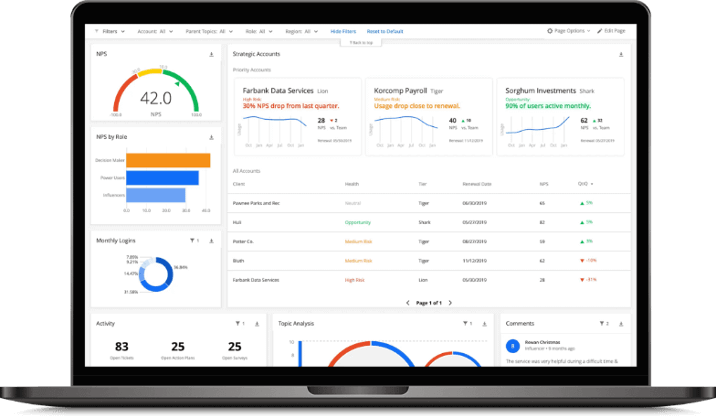It still holds true today that it costs much less to retain an existing customer than it does to acquire a new one. That’s why organizations invest billions every year into customer retention programs to drive customer loyalty and encourage their customers to spend more.
In this guide we’re looking at the strategies and methods companies can employ to improve customer retention and deliver back to the bottom line.
Free eBook: The ultimate guide to improving customer loyalty
What is customer retention?
Customer retention refers to a business strategy that aims to retain as many customers as possible and improves customer relationships. Your customer retention rate, or how many loyal customers you can keep over a specified period, is directly affected by your customer churn (how many customers lost) and your customer acquisition (how many new customers join).
As you might expect, there’s more than one way of going about building customer retention strategies — by and large, any process that promotes customer loyalty can be classed as a customer retention activity.
Why is understanding customer retention important?
Customer acquisition is undoubtedly important to any business, but if businesses spend the bulk of their time and energy on trying to woo new customers at the expense of keeping existing ones, they’ll soon see an increase in churn and a downward trend in customer satisfaction.
As a consumer yourself, you may be able to recall a time when an introductory rate for new customers was much better than what was being offered to existing ones – and that often fosters resentment towards the brand in question for not valuing loyalty.
Besides this, it’s actually cheaper by far to keep existing customers than it is to win over new ones.
It’s 5-25X more expensive to acquire a new customer as it is to retain an existing one
– HBR
So, understanding, monitoring, and trying to build customer retention is an essential way of meeting customer expectations. Retaining customers is both a way to improve your business’ core KPIs and a practice that – simply by taking the right steps – will yield a host of other benefits.
By focusing on ways to increase customer retention, you’ll also…
Understand the customer lifetime value for your business
Customer lifetime value is the total worth to a business of a customer over the whole period of their relationship. Knowing your CLV helps businesses develop strategies to acquire new customers and retain existing ones while maintaining profit margins.
Improve customer satisfaction
Customers who are incentivized to stick around – that is, the ones who feel listened to, understood, and valued – are much more likely to feel satisfied with your services. Handily, satisfied customers are much more likely to recommend your brand to their peers, which can boost overall customer acquisition figures.
Create opportunities for customer feedback
Focusing on customer retention rates will usually result in more customers who feel loyal to your brand. Those loyal customers are a great resource when it comes to gathering feedback, as they’re often more likely to respond to surveys, and can tell you how things are going over longer periods. Customer feedback is an incredibly important resource when it comes to continuous improvement across the business, especially in closing experience gaps you might not otherwise realize are there.
Decrease customer churn rate
Any area of the business you turn a critical and constructive eye to should, in theory, benefit from that attention. So proactively building a program for customer retention – whether that’s a customer loyalty program, adjusting your price offerings, or simply making experiential changes – will have a positive impact on customer churn. In other words? As retention rates go up, churn goes down, leading to an overall more efficient and profitable business.
Customer retention management
Customer retention management is a formalized process by which organizations manage the relationships with existing customers to encourage them to stay longer and spend more.
In B2B, it’s usually managed by a customer success team that builds close relationships with individual accounts and customers, working closely with them to retain and grow the account over a period of time.
In B2C it’s slightly different – while you might have a customer retention team, it’s almost impossible to build 1-to-1 relationships with every customer. So instead, the customer retention team usually sets a strategy and works closely with other customer-facing teams from across the organization to deliver on it.
For example, your customer retention team may look to introduce personalized offers for certain customer segments in a bid to boost loyalty. They may then look to the marketing team to help them establish regular communication with those customers.
Or, you may offer a special discount or price for those at risk of customer churn. This is something you’d likely have agreed with the product team and then communicated to your contact center agents, giving them something to offer customers if they phone to cancel a contract for example.
What does a customer retention strategy involve?
Most customer retention strategies are based on the numbers – ie how much you’re willing to invest to keep your customers loyal. That investment could be put into developing exclusive product offerings for your best customers, or invested in discounting to prevent customer churn.
When you’re starting to think about customer retention strategies, there are a few questions you’ll need to answer:
Who are your customer segments?
Not all customers are the same, so it’s worthwhile using customer segmentation to identify the needs of different groups of customers as well as identify which ones are your ‘best’ customers.
What’s your cost to serve?
You need to know how much you’re paying to serve each customer segment to make an informed decision about how much to invest in customer retention.
How much do you know about your customers?
If you’re investing in retention programs, you need to know what appeals to different customer segments. Some customers may be driven by price, while others might be driven by exclusivity or service level. Deep customer research will help you understand what drives loyalty for different groups, and using those insights you can design a retention strategy that’s tailored to your customer base, rather than a one-size-fits-all strategy.
How much customer churn are you willing to risk?
It’s important to remember that not all customers need saving. Some customers cost more to serve than others, so you need to be able to understand the value of each customer or customer segment to your business.
If two customers spend the same amount every year, but one costs 3 times as much to serve and retain, it may be worth cutting them loose and investing that money in another segment or customer that would ultimately deliver more profit to the bottom line.
It’s why not all customer churn is bad. Most companies will have an acceptable level of churn as they look to let the unprofitable customers go while retaining their most profitable customers.
What will it take to retain customers?
For those loyal customers that you want to keep, you’ll need to decide how you will improve customer retention. Understanding how customers feel through research, thoroughly understanding that particular customer base, and developing customer relationships through thought-out touchpoints can help you to increase your customer retention rate.
This can be costly – but ultimately, even the simplest of tactics can have a big payoff for retaining your customer base and extending your customer lifetime.
Customer retention tactics
There’s no hard and fast rule about what tactics to use to drive customer loyalty — in fact, some of the most successful ones are those that differentiate one brand from its competitors and are based on unique insights into its customer base.
That said, there are several tried and tested customer retention tactics many brands will employ:
1. Email newsletters and personalized offers
When a customer shares their email address with you and opts into marketing messages, it’s a strong sign that they already feel positive towards your brand and your cue to build relationships. You can build on this and keep them onboard over a longer period by being a regular presence in their inbox. As email is a free channel, it’s a relatively low-cost way to improve customer retention.
That doesn’t just mean sending out blanket marketing messages though. For best results, use your CRM data to personalize emails to loyal customers and celebrate their relationship with the brand, focusing on key milestones. Try a birthday discount code or a message that lets them know they’ve been shopping with you for a year (or more) and thank them for their business.
Even better, try using automated emails that are triggered through their actions. For example, when customers make a purchase, send them an email explaining how that product or service works. Alternatively, when customers haven’t been involved for a pre-determined period, send an automated email that is tailored to their past purchases to encourage them to return.

2. Pre-empting churn
As well as looking after the happy customers you have, extend your reach to the ones who have wandered off, or are about to. Reactivation for existing customers within the EU may have gotten trickier since GDPR regulations came in – you can no longer simply use a mailing list – but you can still reach retained customers who are showing signs of being about to lapse.
To discover which of your existing customers are at risk of churn, it’s helpful to have data showing how previous customers behaved in the same situation. Less frequent purchases of products and services, lower levels of engagement, or lukewarm feedback can all point toward a customer looking for the exit.
It’s another good argument for tracking your customer journeys and developing stronger customer relationships. It’s worth understanding why customers buying in a certain way do so, and how your products and services are being marketed through channels such as social media. Tying in all your understanding of your customers into their long-term behavior allows you to provide a much more tailored customer experience that will reduce customer churn.
3. Rewards for your best customers
Not all customers are created equal. Big spenders, repeat purchasers, and those who bring in new customers with referrals and reviews all deserve some recognition and a special effort when it comes to increasing customer retention. You can give it to them through a rewards program that ties extra benefits to loyalty behaviors.
For some companies, this is linked to spending – they might earn 1 loyalty point per $ spent, for example. For others, a multi-faceted strategy works better. The customer may receive a reward for leaving a review, recommending a friend, or following one of your social media accounts. Which option you choose might depend on the number of customers you have or your other business goals.
Regardless of the tactic, the underlying principles are the same — get to know your customers, what drives their loyalty, and look to invest in the kinds of experiences they want, whether that’s rewards, discounts, or access to different service levels.
Customer retention examples: How to create loyal customers
Starbucks
Now something of a staple in the food and drink industry, Starbucks was something of a pioneer with its Starbucks Rewards program. Using its app, customers can earn rewards for every purchase to be used later on free food and drink. Payment needs to be made through the app itself, generating even more customer data Starbucks can use to personalize its offering and gain a better understanding of what each customer needs.
Amazon Prime
Something of an outlier, Amazon Prime is part customer loyalty program, part experience. Customers pay to be part of the service and in return receive benefits like same-day delivery, access to video and music streaming, and exclusive discounts and offers. Yes, customers pay to join, making it a service in itself, but the knock-on effect for Amazon is a huge boost in retention as the subscription makes Amazon its members’ first choice when it comes to online shopping.
TOMS
A great example of understanding your customers is TOMS’ ‘One for One’ program. When customers buy a pair of TOMS shoes, the company donates a pair to people in need. It harks back to the company’s brand values and acknowledges that its customers are driven not by discounts and rewards, but by their desire to do good. It just goes to show that not all customer retention programs need to focus on monetary rewards for your customers.
Nike
The sportswear giant understands that sport and exercise is a team game — people are much more likely to exercise as part of a group than on their own. So they developed apps and partnerships to build a sense of community like Nike Running Club, encouraging solo runners to team up with other runners online and replicate the sense of team and competition that many people demand.
How to measure customer retention rate in your business
Customer retention isn’t a ‘one and done’ activity — it’s an always-on program that needs careful monitoring to ensure it continues to deliver back to the business.
Many organizations will use customer retention software to monitor retention, understand their customers better, and take action to evolve their retention program to react to customers’ changing needs.
The first step is to calculate your customer retention. It’s a pretty simple calculation – customer retention rate is usually expressed as a percentage of customers retained in a particular period.
Retention Rate = ((CE-CN)/CS)) X 100CE = number of customers at end of period
CN = number of new customers acquired during period
CS = number of customers at start of period
So, say you had 1,000 customers at the beginning of a quarter, acquired 200 new customers during the quarter, and had 800 customers at the end of the quarter, you’d calculate customer retention rate like so:
((800-200)/1,000)) x 100 = 60%
That means over the quarter you retained 60% of your existing customers.
What is a good customer retention rate?
You might not love this answer, but the only one we can honestly provide is: 100%. With the exception of any customers who cost more to serve than they bring in (as mentioned earlier), that’s the true figure all businesses should be striving for in terms of customer success. Because anything below that leaves room for improvement, it’s helpful to think of retaining existing customers as an ongoing process.
It’s helpful to have some kind of rough benchmark though, right? Average customer retention rates do vary by industry, after all. According to research by Statistica conducted in 2020, here’s an average read on how things differ across various sectors:
Retail: 63%
Banking: 75%
Telecom: 78%
IT: 81%
Insurance: 83%
Professional services: 84%
Media: 84%
How do you increase customer retention rate?
Measuring customer retention is only half the job. It’s what you then do with that information that’s really important. The goal is to enter a continual process of measuring and monitoring, implementing tactics that can increase how well you retain customers, then measuring again to see what’s working.
Here are a few tips to measure and continually monitor customer retention in your business:
1. Track customer retention in real-time
You need to know how your retention strategies are working – and the only way to do that is to have a measure of customer churn. While some organizations will report on it periodically, say quarterly or annually, the best brands have always-on data, showing them day-to-day what’s happening to their retention rate.
2. Understand the bottom-line impact
We talked about it earlier in this guide, but it’s essential to understand how much churn is acceptable, and which customers you are happy to let go of. So make sure you include operational data about which customers are churning. It’s useful here to have a metric like customer lifetime value (CLV) to refer to when deciding which customers you want to invest in retaining.

3. Understand why people churn
Whether you have an existing customer retention system or not, it’s impossible to optimize it if you don’t know why people churn. So ask your customers for feedback when they do churn and use that experience data to get to the root cause. Combined with your operational data, you can get a picture of who’s churning, what drives the actions of different customer segments, and crucially the actions you need to take to fix it. You could also use conversational analytics to understand the emotional, effort and sentiment customers feel during any given interaction with your brand. This will help indicate their likelihood to churn, and why.
4. Share insights across the organization
We’ve already seen just how many teams are involved in driving customer retention. So it’s essential to share your customer data with the rest of the organization so they can take action on it.
Make a list of all the customer-facing teams that have an impact on retention, and make sure they have all the information they need to make the right decisions for customers, whether it’s designing a broader retention strategy or they’re on the frontlines making in-the-moment decisions that will drive customer satisfaction and ultimately impact retention.
Working with those teams, you can ensure that your customer experience program plugs into the systems they’re already using so they can take the right actions for customers in their day-to-day work.
Keep current customers forever
Ultimately, if you want to turn customers into fans, you’ll need the right software that can keep track of retention and customer churn rate 24/7, as well as generate actionable insights from every touchpoint, and every interaction.

Qualtrics CustomerXM™ is a platform designed to do exactly that – using AI and machine learning to turn typically disparate data sets into clear ways you can move the needle, build exceptional customer service workflows, and bolster your customer retention efforts like never before.
Free eBook: The ultimate guide to improving customer loyalty